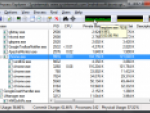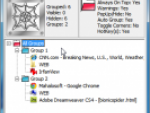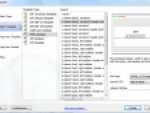When I firstly saw the Microsoft Expression set, I didn't understand why the classical gray design of software disappeared. Black color was very strange to me, but someone told me that the black background is much better for designers. Over time I have accepted a black/dark background and inverse colored controls in Microsoft Expression.
[inline:ms-expression-design-2.png]
Of course, Microsoft continues in gray/black tradition in the latest Microsoft Expression 2. You could see it in the picture below, other screenshots can be found at Screenshots Archive in the Microsoft Expression section.
From the grey to the blue
I do not know where goes your memory back, but I am sure you still remember Windows 9x/2000 and software written for this family of Microsoft's operating systems. There actually existed grey, which replaced the somewhat unpleasant white in Windows 3.1 and earlier versions. The gray design looked nice. It brought a whole range of new icons, which persisted with minor adjustments to the present. For example, the latest Word 2007 has the save button with a floppy disk, although new beginning users does not know how a floppy looks like. When did you have the floppy in your hand lastly?
Life is changing so people who define the direction for the user interface design development decided to replace the boring grey by more lively blue. This has happened for MS Office 2003 which came with a transparent selection in menu items, blue toolbars and other elements.
Real blue victory came with Windows XP. I remember how the computer journalist welcomed this design with confusion. New Windows looked like coloring books. However the blue user interface won, green and silver windows scheme was almost forgotten.
From the blue to the transparency
Software developers copy their software design from the operating system and its basic applications. The big inspiration in the world of Windows is also MS Office suite or Visual Studio. The blue color remained dominant in various forms practically today. The basic look of MS Office 2007 is still blue. It brings, however, a new element - the transparency (I do not want to talk about the Ribbon).
[inline:word-2007.png]
Full use of the transparency could try the Windows Vista users. Here, however, appears already tuning into the darker colors, which also can be set up in mentioned MS Office 2007.
An era of black applications
I think that black color will play an increasing role. As software manufacturers copy the Ribbon, they will start copying of the black user interface. Two big software producers Microsoft and Adobe has begun the black revolution. I have already mentioned the Microsoft Expression, black window decorations can be found in applications in Adobe CS3 suite too. Black user interface can be found in the Adobe Media Player available free of charge or in the new and version of Adobe Acrobat - more precisely in online and desktop client for Adobe.com.
[inline:adobe-media-player.png]
Who did it? Silverlight and Adobe AIR.
It isn't without interest that the black appeared with the advent of Silverlight and .NET Framework 3 from Microsoft and in Adobe AIR. Thanks to strong massage from both large software companies certainly will shortly be taking bigger applications development that make use of these technologies and black to occupy your monitors. Are you looking forward to the energy saving or you don't welcome this changes?
[inline:acrobatcom.png]








